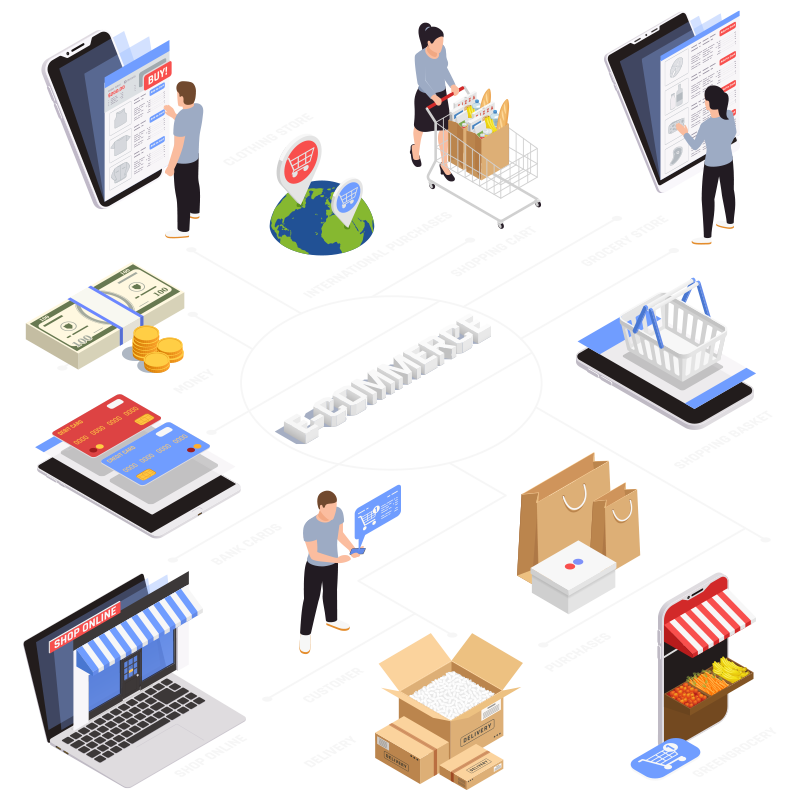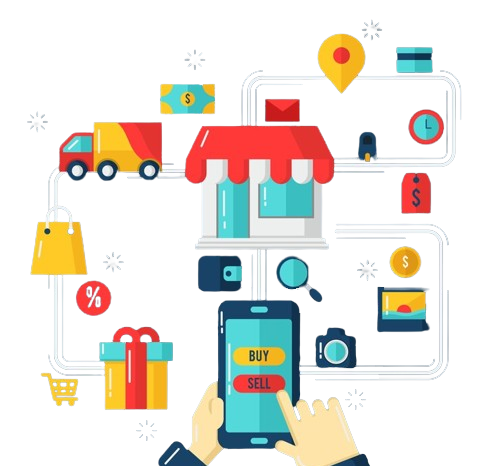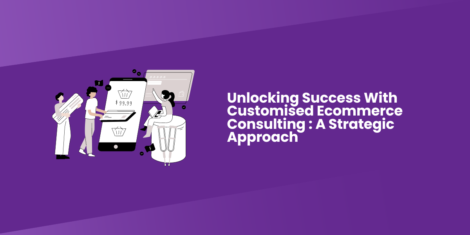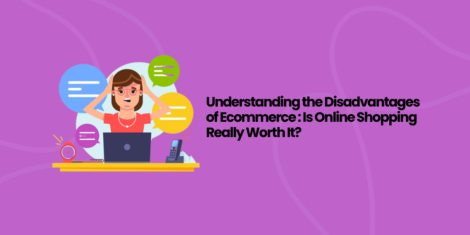The world of ecommerce is evolving rapidly, and 2024 is no exception. With shifting consumer behaviors and technological advancements, understanding the top-se ...
Every Product is Special
Introduction To
E-commerce
E-commerce refers to the buying and selling of goods or services using the internet, and the transfer of money and data to execute these transactions. It’s widely used for online shopping.
Every Product is Special
Introduction To
E-commerce
E-commerce refers to the buying and selling of goods or services using the internet, and the transfer of money and data to execute these transactions. It’s widely used for online shopping.

What is
E-Commerce?
E-commerce, or electronic commerce, is a dynamic and ever-evolving business model that has revolutionised the way we buy and sell goods and services. At its core, e-commerce leverages the internet to facilitate commercial transactions, allowing businesses and consumers to interact in a digital marketplace.
This technology-driven system has surpassed traditional brick-and-mortar stores in convenience and efficiency, enabling shoppers to make purchases from anywhere at any time. Its impact is far-reaching, significantly altering retail, supply chain management, and customer behavior.
Today, e-commerce is not just a commercial trend; it's a critical component of the global economy, driving innovation, competition, and consumer choice. Whether it's through giant online retailers, small business storefronts, or individual transactions, e-commerce has become an integral part of our daily lives.
Types of
E-Commerce Models
E-commerce operates through various models, each catering to different business needs and customer bases:
Business-To-Consumer (B2C)
Business-To-Business (B2B)
Consumer-To-Consumer (C2C)
Consumer-To-Business (C2B)
History of
E-Commerce
The journey of e-commerce began in the 1970s with the advent of electronic data interchange (EDI), which replaced traditional mailing and faxing of documents with a digital transfer of data.
However, the real breakthrough came with the introduction of the internet in the 1990s, leading to the first online sale: a music CD in 1994. Since then, e-commerce has seen exponential growth. The early 2000s marked the rise of online marketplaces and payment systems, further fueling its expansion.
Today, e-commerce encompasses a wide range of activities, from online shopping and electronic payments to internet banking and online auctions, reflecting its immense growth and evolution.

How E-Commerce Works
E-commerce operates on a seamless flow of actions, beginning with a user accessing an online platform. Here's a basic breakdown
Product Listing
Sellers list their products or services on an e-commerce platform, complete with descriptions, images, and prices.
Customer Browsing
Customers browse these listings, compare options, and make selections.
Order Placement
Once a customer decides, they place an order, often adding items to a virtual cart.
Payment Processing
Customers complete the purchase by paying through integrated payment gateways.
Order Fulfilment
The seller processes the order, which includes packaging and shipping.
Delivery
The product is delivered to the customer, often with options to track the shipment.
After-Sales Service
This includes customer support, returns, refunds, or exchanges if needed.
Advantages of
E-Commerce
E-commerce offers numerous advantages over traditional retail. For businesses, it provides a wider customer reach, not limited by geographic boundaries. The reduced overhead costs of online stores, compared to physical shops, also make it a cost-effective solution. For consumers, the convenience of shopping from home, access to a broader range of products, and the ability to compare prices and read reviews before purchase are significant benefits. Additionally, e-commerce platforms often offer personalised shopping experiences, leveraging data analytics to recommend products. This convenience and personalization have made e-commerce a preferred shopping method for many.
Challenges in
E-Commerce
Despite its advantages, e-commerce faces several challenges. Security concerns, such as data breaches and online fraud, are significant issues, necessitating robust cybersecurity measures. Maintaining customer trust and satisfaction can be challenging, especially with the impersonal nature of online transactions. Logistics and supply chain management also pose difficulties, particularly in ensuring timely deliveries and managing returns. Additionally, the intense competition in the e-commerce space requires businesses to continually innovate and improve their offerings. The dynamic nature of technology and customer preferences also demands adaptability and constant evolution from e-commerce businesses.
The Future of
E-Commerce
E-commerce's future is bright with innovations like AI, VR/AR, and blockchain reshaping the shopping experience. AI personalizes shopping, VR/AR offers immersive previews, and blockchain ensures secure transactions. Integration with social media and mobile commerce expands customer reach, keeping e-commerce at the forefront of retail, adapting to evolving consumer behavior.


The Impact of
E-Commerce on the UK
E-commerce has revolutionized the business landscape in the United Kingdom, leaving an enduring impact on both businesses and consumers. The digital shift has presented new opportunities and challenges for businesses, requiring adaptability to changing consumer preferences. Meanwhile, consumers now enjoy the convenience of online shopping, transforming the way purchases are made. As e-commerce continues to evolve, its influence remains a defining aspect of modern commerce in the UK.
Consumer Behavior and Online Shopping Trends
One of the most striking changes brought about by e-commerce is the shift in consumer behaviour. British shoppers now have access to a vast array of products and services from the comfort of their homes. This convenience has led to a significant increase in online shopping.
The rise of e-commerce giants like Amazon and eBay has transformed the way people purchase goods. Consumers in the UK can explore an extensive range of products, from electronics to fashion, with just a few clicks. Furthermore, the ability to read reviews and compare prices has empowered shoppers to make informed decisions.
In the UK, the convenience of e-commerce has led to a surge in online grocery shopping. Major supermarket chains offer online platforms where customers can order groceries and have them delivered to their doorstep. This shift became even more pronounced during the COVID-19 pandemic when many turned to online shopping for safety and convenience.

E-Commerce in the
Age of Brexit
The UK's departure from the European Union, known as Brexit, brought about changes in e-commerce regulations and trade. Businesses engaged in e-commerce had to navigate new customs procedures and tax rules when selling to EU countries. While this posed initial challenges, many UK e-commerce businesses adapted and continued to serve their European customers.
Brexit also prompted some UK-based companies to focus more on domestic e-commerce to mitigate uncertainties related to international trade. This shift towards a robust domestic market has driven innovation and competition in the UK e-commerce sector.
The Role of Mobile
Commerce (M-Commerce)
Furthermore, the use of personalized recommendations and location-based services in M-commerce platforms has revolutionized marketing strategies, offering users tailored promotions and discounts based on their preferences and geographical location. This customization has increased customer engagement and played a pivotal role in driving sales for businesses in the dynamic UK e-commerce market.
Many UK retailers have invested in mobile apps to enhance the shopping experience. Mobile payment methods, such as Apple Pay and Google Pay, have gained popularity, providing secure and convenient ways for consumers to make online purchases.
E-commerce Business Models
Retail on the Web
Amazon leads as the titan of online retail, yet the realm of e-commerce is open for all to thrive. Utilising partnerships with giants like Amazon and eBay can kickstart your own digital storefront.
Wholesale E-commerce
Alibaba shines as a notable example, dominating the B2B sector while also engaging in direct consumer sales, facilitating global trade for countless businesses.
Dropshipping Dynamics
In dropshipping, a third party manages the inventory and shipping, allowing entrepreneurs to focus on their online storefront. Shopify emerges as a leading platform in this model, offering quick setup for sellers.
Subscription Services
This model encompasses a range of offerings, from recurring product deliveries like Dollar Shave Club to curated experiences and access-based services such as Netflix.
Digital Goods
Unlike tangible products, digital stores specialise in software, art, and online courses. Microsoft stands out in selling digital products, which exist solely in the digital realm.
Crafting and Selling Physical Goods
Platforms like Etsy highlight artisans who create and dispatch their own products, differentiating from retail or drop shipping methods.
Online Services
Selling services online, ranging from financial advice to legal aid, is increasingly feasible and popular due to its low entry barrier.
Starting E-commerce: A Cost-effective Endeavour

E-commerce Operations: The Digital Workflow
Operating an e-commerce site mirrors the dynamics of a physical store, with the added convenience that customers can shop from anywhere, anytime.The process involves accepting orders, processing payments through gateways akin to a digital cash register, and ensuring

Essential E-commerce Website Features
Blogs
From Insights to Influence: Navigating Our E-commerce Odyssey for Innovations, Tips, and Growth Tactics. Empowering Your Retail Tomorrow.
Customised Ecommerce Consulting
Here is Why Customised Ecommerce Consulting is Essential for Your Online Success. In today’s competitive digital marketplace, launching an online store is just ...
Understanding The Disadvantages Ecommerce
Ecommerce has transformed the way we shop, offering unparalleled convenience and access to a vast array of products and services. From the comfort of our homes ...
Ecommerce Sample Best Practices
In today’s digital age, establishing an online presence is more than a trend—it’s a vital component for businesses aiming to thrive. The ecommerce landscape of ...



